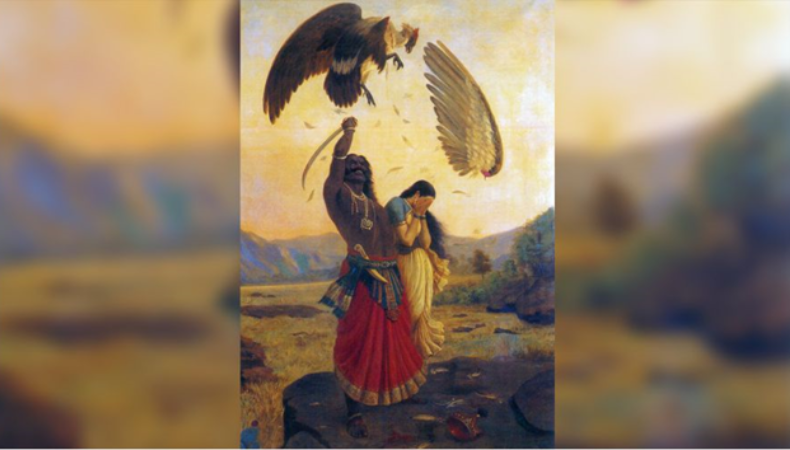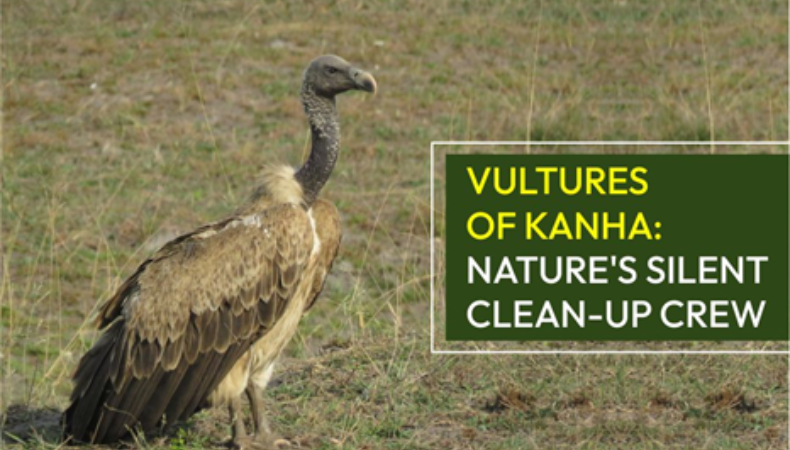Across the picturesque landscapes of India, within the verdant embrace of the Kanha Tiger Reserve, a remarkable story unfolds—a story that centres around one of nature’s most misunderstood yet vital creatures: the vulture.

As we journey through this enchanting landscape, we are drawn into the world of these magnificent birds, seldom acknowledged in the diverse realm of wildlife. While many may not see vultures as beautiful, they play an irreplaceable role in maintaining the delicate balance of our ecosystems.
The ancient epic of the Ramayana tells the tale of Jatayu, a noble vulture-like figure who fought valiantly against the demon king Ravana. This legendary creature embodies the deep respect held for vultures in Indian culture.

In a testament to this reverence, India established its first vulture conservation centre in Pinjore, Haryana, named after Jatayu—a sanctuary dedicated to the protection of these extraordinary scavengers.
Vultures: Nature’s Unsung Guardians
Falling under the clade Accipitrimorphae, vultures are magnificent birds of prey, adorned with hooked beaks and powerful wings. Masters of flight, they soar high above the earth, riding thermal currents as they search for their next meal. While some may be solitary, many species thrive in social gatherings, a breathtaking spectacle as they circle gracefully against the azure sky. Globally, we find 23 distinct species of vultures, divided into two families: the Old World vultures, with 16 species inhabiting Asia, Africa, and Europe, and the New World vultures, a group of 9 that soar across the American continents. In India alone, nine vulture species grace the skies, each with its own unique story to tell.Kanha Tiger Reserve: A Refuge for Vultures
Nestled within the serene Maikal hill ranges of Madhya Pradesh lies Kanha Tiger Reserve—a sanctuary that teems with life. Here, diverse ecosystems unfold, from towering Sal forests to sprawling grasslands and dense bamboo thickets. In this enchanting realm, six species of vultures can be observed, their majestic forms gliding effortlessly overhead. Join us as we explore the world of these magnificent birds.Egyptian Vulture (Neophron Percnopterus)
The Egyptian Vulture, a medium-sized marvel, captivates with its striking appearance. Its white body, adorned with black flight feathers and a bright yellow face, makes it a true opportunist.
Often found near human settlements and waste disposal sites, this adaptable scavenger displays remarkable intelligence, even using tools to access food and has been recorded to dine on droppings from mammals.
Red-Headed Vulture (Sarcogyps Calvus)
Next, we encounter the Red-Headed Vulture, a critically endangered species distinguished by its vibrant red head and neck, contrasting sharply with its dark plumage.
Preferring the cover of forests and open grasslands, it is a solitary scavenger, often found searching for larger carcasses. Yet, it faces dire threats from habitat loss and poisoning, a stark reminder of the challenges these magnificent birds endure.
Indian Vulture (Gyps Indicus)
The Indian Vulture, known for its long, slender bill, graces the skies across the subcontinent. Nesting on high cliffs and treetops, it possesses an extraordinary ability to locate food from great distances.
Sadly, like many of its kin, it is experiencing alarming declines, urging conservationists to take swift action before it becomes a fleeting memory.
White-Rumped Vulture (Gyps Bengalensis)
Darker than its Indian counterpart, the White-rumped Vulture is easily recognized by the distinctive white ruffled feathers at its neck.
Thriving in open areas with nearby nesting trees, it scavenges on large animal remains. Intriguingly, its droppings can alter the acidity of the trees it inhabits, creating a unique ecological relationship.
Himalayan Griffon (Gyps Himalayensis)
Soaring majestically in the high-altitude realms of the Himalayas, the Himalayan Griffon is a true giant of the skies.
With a formidable size and impressive wingspan, it glides effortlessly above rugged terrain. In winter, these magnificent birds migrate to lower altitudes, including the lush landscapes of Kanha, seeking abundant food sources.
Eurasian Griffon (Gyps Fulvus)
Lastly, we meet the Eurasian Griffon, renowned for its vast wingspan and remarkable soaring ability.
Nesting in craggy cliffs, it forages for large carcasses, often joining forces with other vulture species. In Kanha, it contributes to the intricate web of life, a testament to the interconnectedness of nature.



